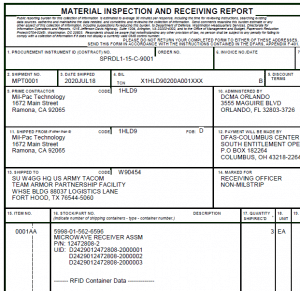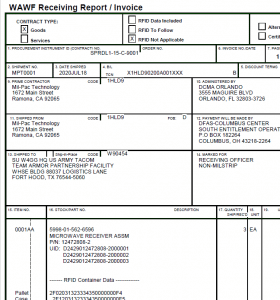The traditional paper DD250 form has long been replaced by the WAWF DD250 Receiving Report transaction for the purposes of Government acceptance of Defense shipments. Government Quality Assurance Representatives (QAR) now sign off on shipments electronically in Wide Area Workflow, rather than on a paper DD250.
The DD250 form is still used by many as a traveler to accompany shipments or otherwise document shipments transacted electronically in WAWF. Because the requirements have changed so much, Mil-Pac created a specialized variant of the DD250 called the WA250 specifically to accommodate WAWF automation.
Prior to full adoption of WAWF the Department of Defense (DOD) required that contractors deliver goods and services on a paper Form DD250, which is entitled the Material Inspection and Receiving Report (MIRR). Contract Line Item (CLIN) data that overflowed the DD250 form (blocks 15 through 20) would be continued on Form DD250C.
WAWF Automation Software
The DD250 form, which at was point was an eight-part form interleaved with carbon-paper, was the receiving document used to record the delivery of goods or services, records pertinent information about the supplies or services, including contract information, delivery date and billing amounts, to name a few. The use of the DD250 as the acceptance instrument of the DoD has been entirely replaced by the WAWF Receiving Report.
This requirement is triggered by contract clause 252.246-7000 of the Defense Federal Acquisition Regulation Supplement (DFARS) and is spelled out in DFARS Appendix F, which was updated to require that Government acceptance occur in WAWF. This process differs from most commercial transactions in that title to the shipment occurs as soon as Government acceptance occurs, which may take place before shipment takes place in what is referred to as Source Acceptance.
Official WAWF Training
With the advent of Wide Area Workflow (WAWF) the submission of DD250s must occur electronically, with few exceptions. Contractors may use the government’s web application or use a WAWF automation system such as MIL-Comply to create and submit electronic data interchange (EDI) transactions. WAWF is the government’s web-based system for accepting, processing and distributing the DD250. In cases where government acceptance is not required, such as for Fast Pay contracts, the Receiving Report may still be used as a packing list and the printed form of a WAWF Invoice. For more information, see other WAWF Invoice Types (full site).
WAWF offers contractors a number of benefits. The system eliminates document distribution mailing times and improves the accuracy of submissions. Most importantly, contractors using the WAWF system receive timely payments for their services. In the past, both contractors and the government processed DD250s manually. Manual completion, processing and archiving made the submission, storage and retrieval of multiple reports a difficult process. Advances in technology have made electronic processing a cross-industry standard, and today, the electronic submission of the Receiving Report is required in almost all cases.
A DD250 Receiving Report for WAWF
The DOD Unique Identifier (UID) and Radio Frequency Identification (RFID) mandates require that contractors submit shipment data electronically to the WAWF system.
Any more than a few RFID-tagged UIDs in a shipment create a challenge that specialized software is designed to overcome. Mil-Pac products such as the MIL-Comply Shipper support traditional DFARS-compliant DD250 forms that can also be submitted electronically to WAWF.
A specialized WAWF version of the DD250, the WA250, includes unique fields that simplify preparation of WAWF Receiving Reports, Invoices and Combos. Both forms fully support UID submission and can automate Mil-Std-129 labeling, including UID and RFID. Printing RFID data on the forms is optional, and for some shipments with numerous tags, using the separate MIL-Comply RFID Pack Report may be better. The WA250 version is often used in WAWF invoice automation because it includes key settings such as LPO, COC, Fast Pay that are required for invoice preparation, but are not found on the traditional DD250. This is due to an expansion by Wide Area Workflow of the data exchanged for defense shipments.
The use of the DD250 as merely a report, rather than as an official procurement instrument, is the relaxation of rules around its use. Gone is the prohibition for printing information that runs over a block boundary. This is essential for printing IUIDs, which at their maximum length of fifty characters easily exceed the width of Block 16 on a DD250 .
Another advantage of the new DFARS rules is the allowance for use of forms like the WA250, which was derived by Mil-Pac to provide dedicated fields for data which came about after the advent of WAWF, such as UIDs and RFIDs. The form includes fields for RFID inclusion (Yes, No or Later), ARP, COC, LPO, Fast Pay, etc. Item description column (Block 16) can include a complete list of all UIDs for each contract line item (CLIN), even though that might exceed the limits placed on item description by WAWF.
The DD250 is also free to include such data, however, use of the WA250 is more indicative that the shipment is being transacted in WAWF and that the form is merely a report. MIL-Comply takes advantage of this by using the PIIN (contract block) to indicate that the shipment transaction is a Reparable Receiving Report (RRR) for a shipment of Government-Furnished Property (GFP).
RFID and UID Packing Data on DD250
MIL-Comply allows the user to include UID data in Block 16 after each CLIN’s item description. A recap of the RFID configuration may also be included, which lays out the contents of each container, including IUIDs. The aggregation of exterior RFID containers (cases) onto pallets is included when applicable. Given the complexity of the all of this data, having a printed report makes doing internal quality assurance easier. It may also be of use to a Government QAR prior to acceptance, as it represents the data to be transmitted to WAWF in the shipment’s EDI Receiving Report or RFID Pack Update transaction.
This data is collected and organized by MIL-Comply Labeling when doing IUID labeling of containers in accordance with Mil-Std-129R. A separate MIL-Comply RFID Pack Report is also available for this purpose.
for applicable shipments. This data is transmitted to WAWF in the shipment’s EDI Receiving Report transaction, but is available in report format for confirming shipment details during or prior to QAR inspection.



